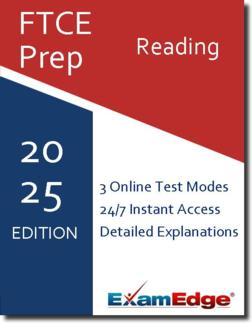FTCE Reading (035) Practice Tests & Test Prep by Exam Edge - Topics
Based on 40 Reviews
- Real Exam Simulation: Timed questions and matching content build comfort for your FTCE Reading test day.
- Instant, 24/7 Access: Web-based FTCE Reading K-12 practice exams with no software needed.
- Clear Explanations: Step-by-step answers and explanations for your FTCE exam to strengthen understanding.
- Boosted Confidence: Reduces anxiety and improves test-taking skills to ace your FTCE Reading K-12 (035).

Understanding the exact breakdown of the FTCE Reading K-12 test will help you know what to expect and how to most effectively prepare. The FTCE Reading K-12 has 100 multiple-choice questions The exam will be broken down into the sections below:
| FTCE Reading K-12 Exam Blueprint | ||
|---|---|---|
| Domain Name | % | Number of Questions |
| Knowledge of research and theories of reading processes | 10% | 10 |
| Knowledge of text types and structures | 10% | 10 |
| Knowledge of reading assessment and evaluation | 10% | 10 |
| Knowledge of learning environments and procedures that support reading | 10% | 10 |
| Knowledge of oral and written language acquisition and beginning reading | 11% | 11 |
| Knowledge of phonics and word recognition | 12% | 12 |
| Knowledge of vocabulary acquisition and use | 12% | 12 |
| Knowledge of reading fluency and reading comprehension | 15% | 15 |
| Knowledge of reading program development, implementation, and coordination | 10% | 10 |


